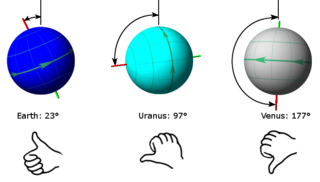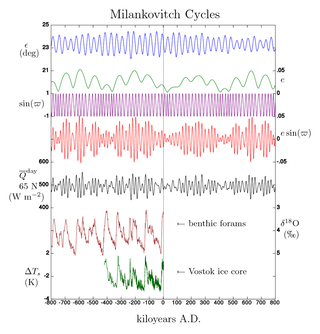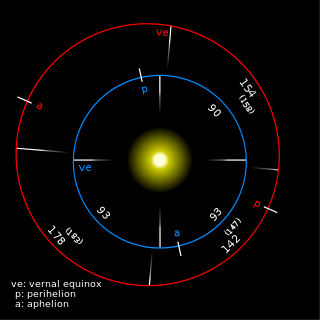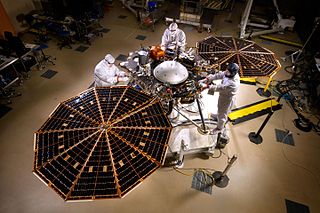
The ecliptic or ecliptic plane is the orbital plane of Earth around the Sun. From the perspective of an observer on Earth, the Sun's movement around the celestial sphere over the course of a year traces out a path along the ecliptic against the background of stars. The ecliptic is an important reference plane and is the basis of the ecliptic coordinate system.

In astronomy, axial tilt, also known as obliquity, is the angle between an object's rotational axis and its orbital axis, which is the line perpendicular to its orbital plane; equivalently, it is the angle between its equatorial plane and orbital plane. It differs from orbital inclination.
The Chandler wobble or Chandler variation of latitude is a small deviation in the Earth's axis of rotation relative to the solid earth, which was discovered by and named after American astronomer Seth Carlo Chandler in 1891. It amounts to change of about 9 metres (30 ft) in the point at which the axis intersects the Earth's surface and has a period of 433 days. This wobble, which is an astronomical nutation, combines with another wobble with a period of one year, so that the total polar motion varies with a period of about 7 years.

The NASA Deep Space Network (DSN) is a worldwide network of American spacecraft communication ground segment facilities, located in the United States (California), Spain (Madrid), and Australia (Canberra), that supports NASA's interplanetary spacecraft missions. It also performs radio and radar astronomy observations for the exploration of the Solar System and the universe, and supports selected Earth-orbiting missions. DSN is part of the NASA Jet Propulsion Laboratory (JPL).

Milankovitch cycles describe the collective effects of changes in the Earth's movements on its climate over thousands of years. The term was coined and named after the Serbian geophysicist and astronomer Milutin Milanković. In the 1920s, he hypothesized that variations in eccentricity, axial tilt, and precession combined to result in cyclical variations in the intra-annual and latitudinal distribution of solar radiation at the Earth's surface, and that this orbital forcing strongly influenced the Earth's climatic patterns.

Though no standard exists, numerous calendars and other timekeeping approaches have been proposed for the planet Mars. The most commonly seen in the scientific literature denotes the time of year as the number of degrees on its orbit from the northward equinox, and increasingly there is use of numbering the Martian years beginning at the equinox that occurred April 11, 1955.

TMK was the designation of a Soviet space exploration project to send a crewed flight to Mars and Venus without landing.

The atmosphere of Mars is the layer of gases surrounding Mars. It is primarily composed of carbon dioxide (95%), molecular nitrogen (2.8%), and argon (2%). It also contains trace levels of water vapor, oxygen, carbon monoxide, hydrogen, and noble gases. The atmosphere of Mars is much thinner than Earth's. The average surface pressure is only about 610 pascals (0.088 psi) which is less than 1% of the Earth's value. The currently thin Martian atmosphere prohibits the existence of liquid water on the surface of Mars, but many studies suggest that the Martian atmosphere was much thicker in the past. The higher density during spring and fall is reduced by 25% during the winter when carbon dioxide partly freezes at the pole caps. The highest atmospheric density on Mars is equal to the density found 35 km (22 mi) above the Earth's surface and is ≈0.020 kg/m3. The atmosphere of Mars has been losing mass to space since the planet's core slowed down, and the leakage of gases still continues today. The atmosphere of Mars is colder than Earth's. Owing to the larger distance from the Sun, Mars receives less solar energy and has a lower effective temperature, which is about 210 K. The average surface emission temperature of Mars is just 215 K, which is comparable to inland Antarctica. Although Mars' atmosphere consists primarily of carbon dioxide, the greenhouse effect in the Martian atmosphere is much weaker than Earth's: 5 °C (9.0 °F) on Mars, versus 33 °C (59 °F) on Earth. This is because the total atmosphere is so thin that the partial pressure of carbon dioxide is very weak, leading to less warming. The daily range of temperature in the lower atmosphere is huge due to the low thermal inertia; it can range from −75 °C (−103 °F) to near 0 °C (32 °F) near the surface in some regions. The temperature of the upper part of the Martian atmosphere is also significantly lower than Earth's because of the absence of stratospheric ozone and the radiative cooling effect of carbon dioxide at higher altitudes.

Mars is the fourth planet and the furthest terrestrial planet from the Sun. The reddish color of its surface is due to finely grained iron(III) oxide dust in the soil, giving it the nickname "the Red Planet". Mars's radius is second smallest among the planets in the Solar System at 3,389.5 km (2,106 mi). The Martian dichotomy is visible on the surface: on average, the terrain on Mars's northern hemisphere is flatter and lower than its southern hemisphere. Mars has a thin atmosphere made primarily of carbon dioxide, and two irregularly shaped natural satellites, Phobos and Deimos.
This page describes exoplanet orbital and physical parameters.

The ExoMars Trace Gas Orbiter is a collaborative project between the European Space Agency (ESA) and the Russian Roscosmos agency that sent an atmospheric research orbiter and the Schiaparelli demonstration lander to Mars in 2016 as part of the European-led ExoMars programme.

The Interior Exploration using Seismic Investigations, Geodesy and Heat Transport (InSight) mission was a robotic lander designed to study the deep interior of the planet Mars. It was manufactured by Lockheed Martin Space, was managed by NASA's Jet Propulsion Laboratory (JPL), and two of its three scientific instruments were built by European agencies. The mission launched on 5 May 2018 at 11:05:01 UTC aboard an Atlas V-401 launch vehicle and successfully landed at Elysium Planitia on Mars on 26 November 2018 at 19:52:59 UTC. InSight was active on Mars for 1440 sols.
Rosalind Franklin, previously known as the ExoMars rover, is a planned robotic Mars rover, part of the international ExoMars programme led by the European Space Agency and the Russian Roscosmos State Corporation. The mission was scheduled to launch in July 2020, but was postponed to 2022. The 2022 Russian invasion of Ukraine has caused an indefinite delay of the programme, as the member states of the ESA voted to suspend the joint mission with Russia; in July 2022, ESA terminated its cooperation on the project with Russia. As of May 2022, the launch of the rover is not expected to occur before 2028 due to the need for a new non-Russian landing platform.

The ExoMars Kazachok was a planned robotic Mars lander led by Roscosmos, part of the ExoMars 2022 joint mission with the European Space Agency. Kazachok translates as "Little Cossack", and is also the name of an East Slavic folk dance.
Astronomical nutation is a phenomenon which causes the orientation of the axis of rotation of a spinning astronomical object to vary over time. It is caused by the gravitational forces of other nearby bodies acting upon the spinning object. Although they are caused by the same effect operating over different timescales, astronomers usually make a distinction between precession, which is a steady long-term change in the axis of rotation, and nutation, which is the combined effect of similar shorter-term variations.

The gravity of Mars is a natural phenomenon, due to the law of gravity, or gravitation, by which all things with mass around the planet Mars are brought towards it. It is weaker than Earth's gravity due to the planet's smaller mass. The average gravitational acceleration on Mars is 3.72076 ms−2 and it varies. In general, topography-controlled isostasy drives the short wavelength free-air gravity anomalies. At the same time, convective flow and finite strength of the mantle lead to long-wavelength planetary-scale free-air gravity anomalies over the entire planet. Variation in crustal thickness, magmatic and volcanic activities, impact-induced Moho-uplift, seasonal variation of polar ice caps, atmospheric mass variation and variation of porosity of the crust could also correlate to the lateral variations. Over the years models consisting of an increasing but limited number of spherical harmonics have been produced. Maps produced have included free-air gravity anomaly, Bouguer gravity anomaly, and crustal thickness. In some areas of Mars there is a correlation between gravity anomalies and topography. Given the known topography, higher resolution gravity field can be inferred. Tidal deformation of Mars by the Sun or Phobos can be measured by its gravity. This reveals how stiff the interior is, and shows that the core is partially liquid. The study of surface gravity of Mars can therefore yield information about different features and provide beneficial information for future landings.
Rotation and Interior Structure Experiment (RISE) is a radio science experiment onboard InSight Mars lander that will use the spacecraft communication system to provide precise measurements of Mars' rotation and wobble. RISE precisely tracks the location of the lander to measure how much Mars's axis wobbles as it orbits the Sun. These observations will provide new constraints on the core radius and help determine whether the core of Mars is mostly liquid, and which other elements, besides iron, may be present. This study will also help scientists understand why Mars's magnetic field is so weak, as compared to Earth's.
Mioara Mandea is Head "Science Coordination" Department, Strategy Directorate at the Centre National d'Etudes Spatiales. She won the 2018 European Geosciences Union Petrus Peregrinus Medal and has previously served as their General Secretary. She is Officer, National Order of Merit (2023). She is best known for her work on geomagnetic jerks, sub-decadal changes in the Earth's magnetic field.

Véronique Dehant is a Belgian geodesist and geophysicist. She specializes in modeling the deformation of the Earth's interior in response to the planet's rotation and the gravitational forces exerted upon it by the Sun and Moon. She has used similar techniques to study Mercury, Venus, Mars and the icy satellites of the outer planets. She primarily works at the Royal Observatory of Belgium, but also serves as an Extraordinary Professor at the Université Catholique de Louvain.

Hera is a space mission in development at the European Space Agency in its Space Safety program. Its primary objective is to study the Didymos binary asteroid system that was impacted by DART and contribute to validation of the kinetic impact method to deviate a near-Earth asteroid in a colliding trajectory with Earth. It will measure the size and the morphology of the crater created by and momentum transferred by an artificial projectile impacting an asteroid, which will allow measuring the efficiency of the deflection produced by the impact. It will also analyze the expanding debris cloud caused by the impact.















